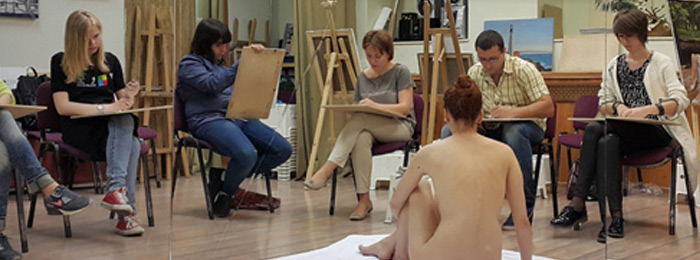Question from William, Drawing Academy student
It seemed like in lesson 15 of Drawing Academy, you were recommending going to museum to sketch old master works, so I went to try it out. Also, it seems like you are putting sketching classical sculptures in the same category as sketching paintings. Wouldn’t sketching a sculpture of Heracles be different than sketching a painting?
What do you recommend for a deeper study in human anatomy? I do not have access to a model.
Hi William,
Yes, copying great masters will help you to improve your art techniques & style and develop good taste in art.
Drawing three-dimensional sculptures is very different from copying flat paintings or drawings.
Making copies of two-dimensional artworks helps to understand techniques and methods used by the Old Masters, as well as imitate their style and develop your art techniques based on the heritage of traditional art.
Drawing classical sculptures requires a different set of skills because you draw real three-dimensional objects. In constructive drawing of sculptures and busts, you will practice drawing in perspective, understanding of foreshortening, measuring proportions, alignments & angles, understanding the human anatomy, proportions of a human body, head and face – and above all, learn classical canons of human figures and portraits which have been developed since the time of Ancient Greece and Rome.
Regarding a common excuse that you don’t have an access to a model, of course, you have an immediate and constant access to the best model you can wish for: yourself. You can draw self-portraits looking in a mirror – full face and three-quarters, as well as profile using two mirrors; you can also draw your hands in various gesture poses, depict your feet and, if you want, the full body looking in a big mirror.
Just go out with a sketchpad and make fast sketchers of people walking on streets or resting in parks, sitting in cafes or standing and waiting for a bus. A two-second glaze on a stranger is not considered as invasion of someone else privacy and is long enough to get an impression of a pose and shape you can practice drawing in one or two lines in 10 to 20-second sketches. Such gesture drawings will be a great exercise as long as you do them thoughtfully. Each time you’ll find yourself solving such questions as “what are the main proportions of a human figure, what is the main angle of this pose, what figure does this pose resemble,” and so on.
You can ask your friends, colleagues and even complete strangers if they want you to draw their portrait free of charge. The only expense in this case is a piece of paper and a few millimeters of pencil lead – a minuscule price to pay for a model. I’m sure after making a number of different life-drawing portraits, someone will ask you if you could draw the full figure portrait. There are many solution to the “How to find models for drawing” challenge.
In the Anatomy Master Class we give the best information for fine artists who want to quickly learn how to draw realistic figures and portraits with the full knowledge of the human anatomy.





